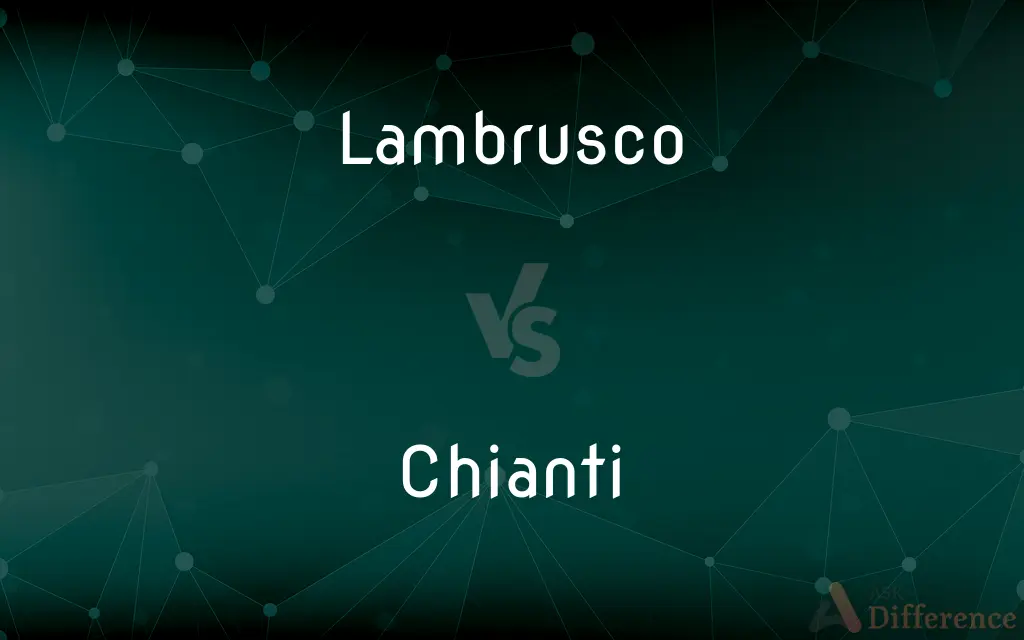Lambrusco vs. Chianti — What's the Difference?
Edited by Tayyaba Rehman — By Urooj Arif — Updated on April 9, 2024
Lambrusco, often sparkling and fruity, hails from Italy's Emilia-Romagna. Chianti, a dry, robust red, is iconic of Tuscany, embodying its rich heritage.

Difference Between Lambrusco and Chianti
Table of Contents
ADVERTISEMENT
Key Differences
Lambrusco and Chianti both represent Italy's rich viticultural heritage but differ significantly in style and taste profile. Lambrusco, primarily produced in Emilia-Romagna, is known for its sparkling, slightly sweet nature, offering a range of flavors from tart berry to spicy notes. Chianti, on the other hand, originates from Tuscany's Chianti region, famous for its dry, medium to full-bodied red wines with high tannin content and flavors of red fruit, leather, and herbs.
While Lambrusco's appeal often lies in its accessibility and versatility, pairing well with a variety of foods including rich, fatty dishes and even pizza, Chianti commands attention with its structured complexity, making it an excellent companion to red meats, pasta with red sauces, and aged cheeses. This difference in pairing potential highlights their distinct profiles.
Lambrusco's winemaking process often involves secondary fermentation to achieve its characteristic fizz, whereas Chianti's production focuses on aging in oak barrels to develop its depth and complexity. This fundamental difference in vinification reflects in their unique sensory experiences.
The history of Lambrusco is rooted in a more casual, everyday wine-drinking culture, appreciated for its refreshing quality and modest price point. Chianti, however, boasts a storied past involving centuries of refinement and regulation, embodying the essence of Italian winemaking tradition and terroir.
Despite their differences, both Lambrusco and Chianti share the commonality of being deeply embedded in Italian culture, each telling a unique story of its region through the grape varieties used, winemaking techniques, and the evolution of its popularity both in Italy and globally.
ADVERTISEMENT
Comparison Chart
Origin
Emilia-Romagna, Italy
Tuscany, Italy
Wine Type
Sparkling and semi-sparkling
Still red wine
Taste Profile
Fruity, slightly sweet, refreshing
Dry, robust, tannic
Ideal Pairing
Rich, fatty dishes, pizza
Red meats, pasta with red sauces, cheese
Vinification Process
Secondary fermentation for fizz
Aging in oak barrels
Compare with Definitions
Lambrusco
Made primarily in the Emilia-Romagna region.
While touring Emilia-Romagna, we sampled several varieties of Lambrusco.
Chianti
Pairs well with hearty dishes, particularly meats and cheeses.
For our Italian-themed dinner, we chose a Chianti to complement the pasta and aged Parmesan.
Lambrusco
Often enjoyed as an aperitif or with casual meals.
Lambrusco’s refreshing quality makes it an ideal choice for an aperitif.
Chianti
Made primarily from Sangiovese grapes.
The depth of the Chianti is attributed to the Sangiovese grapes it's made from.
Lambrusco
Comes in dry (secco), semi-sweet (amabile), and sweet (dolce) varieties.
Depending on the meal, you might choose a secco or dolce Lambrusco.
Chianti
Often aged in oak barrels, contributing to its complexity.
The oaky undertones of the Chianti were developed through barrel aging.
Lambrusco
A lightly sparkling red wine from Italy known for its fruity and slightly sweet taste.
The Lambrusco, served chilled, was the perfect complement to our summer picnic.
Chianti
Protected by DOCG status, ensuring quality and traditional production methods.
This Chianti boasts DOCG status, guaranteeing its high quality.
Lambrusco
Known for its deep red color and bubbly nature.
The deep red Lambrusco fizzed delightfully in our glasses.
Chianti
A dry red wine from the Tuscany region, characterized by its robust flavor and high tannin content.
The Chianti's robust flavors paired perfectly with our steak dinner.
Lambrusco
Lambrusco (; Italian: [lamˈbrusko]) is the name of both an Italian red wine grape and a wine made principally from said grape. The grapes and the wine originate from four zones in Emilia-Romagna and one in Lombardy―principally around the central provinces of Modena, Parma, Reggio-Emilia, and Mantua.
Chianti
A Chianti wine (, also US: , Italian: [ˈkjanti]) is any wine produced in the Chianti region of central Tuscany. It was historically associated with a squat bottle enclosed in a straw basket, called a fiasco ("flask"; pl.
Chianti
A dry red table wine made from a blend of different varieties of grapes, originally produced in northwest Italy.
Chianti
Alternative case form of Chianti
Chianti
A dry red Italian table wine from the Chianti region of Tuscany.
Chianti
Dry red Italian table wine from the Chianti region of Tuscany
Common Curiosities
Where is Chianti made?
In the Tuscany region of Italy, primarily from Sangiovese grapes.
Is Lambrusco a casual wine?
Yes, it's often enjoyed in a casual setting, appreciated for its refreshing and slightly sweet taste.
What is Lambrusco?
A sparkling red wine from Italy, known for its fruity flavor and slight sweetness.
What food pairs well with Chianti?
Red meats, pasta with red sauces, and aged cheeses are ideal pairings for Chianti.
What distinguishes Chianti in terms of regulation?
Chianti has DOCG status, ensuring it meets strict quality and production standards.
Is Lambrusco suitable for summer?
Yes, its refreshing quality makes it particularly suitable for warmer weather.
Can Lambrusco be dry?
Yes, Lambrusco comes in dry (secco), semi-sweet (amabile), and sweet (dolce) varieties.
How is Chianti aged?
Chianti is typically aged in oak barrels, which contributes to its complexity and robust flavor.
What makes Lambrusco unique?
Its lightly sparkling nature and versatility in sweetness levels make it unique.
What grapes are used in Chianti?
Primarily Sangiovese grapes.
How should Lambrusco be served?
Chilled, to enhance its refreshing qualities.
Why is Lambrusco popular for parties?
Its easy-drinking nature and affordability make it a popular choice for gatherings.
Can Chianti be served with fish?
Typically, Chianti is better suited to red meats and hearty dishes rather than fish.
What is the alcohol content of Chianti?
It varies, but typically ranges from 12% to 14% by volume.
How long can Chianti be aged?
Depending on the quality, Chianti can be aged for several years to develop further complexity.
Share Your Discovery

Previous Comparison
Neurotomy vs. Rhizotomy
Next Comparison
Microtrend vs. MacrotrendAuthor Spotlight
Written by
Urooj ArifUrooj is a skilled content writer at Ask Difference, known for her exceptional ability to simplify complex topics into engaging and informative content. With a passion for research and a flair for clear, concise writing, she consistently delivers articles that resonate with our diverse audience.
Edited by
Tayyaba RehmanTayyaba Rehman is a distinguished writer, currently serving as a primary contributor to askdifference.com. As a researcher in semantics and etymology, Tayyaba's passion for the complexity of languages and their distinctions has found a perfect home on the platform. Tayyaba delves into the intricacies of language, distinguishing between commonly confused words and phrases, thereby providing clarity for readers worldwide.















































